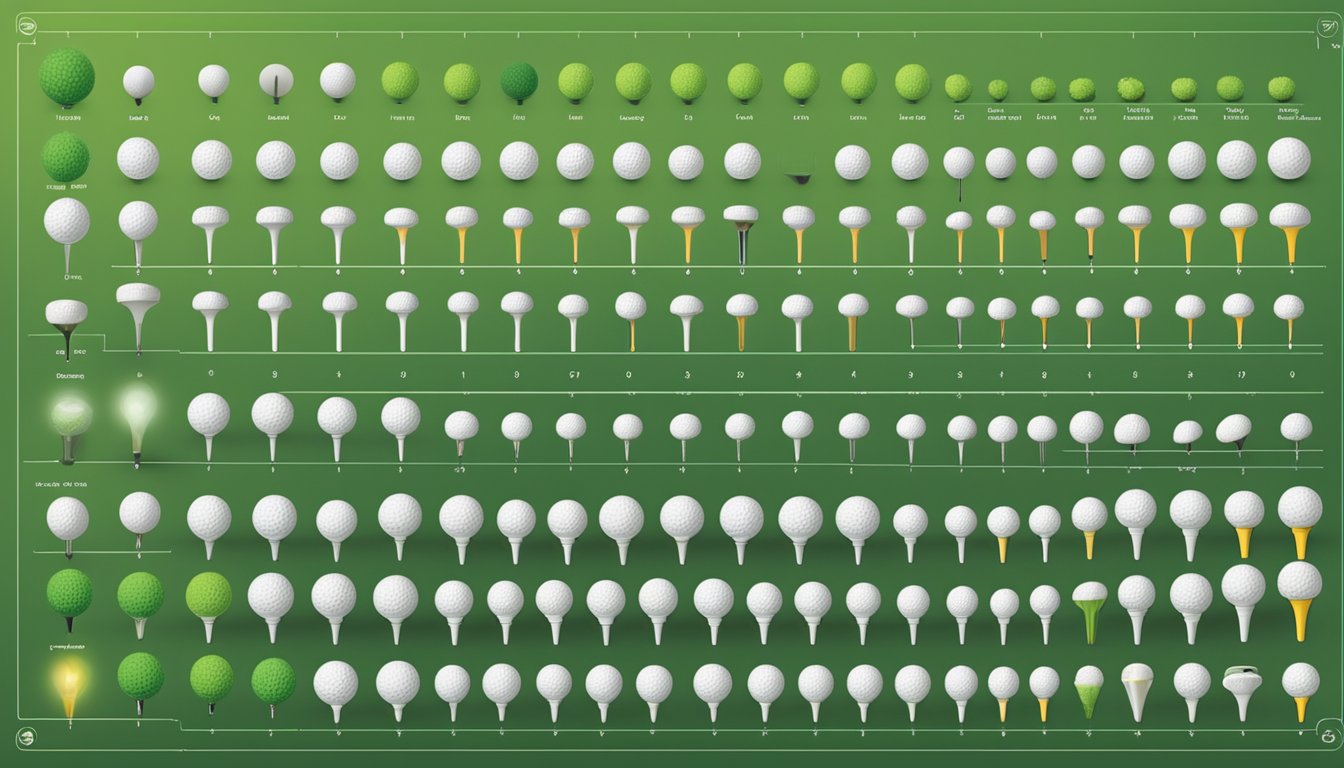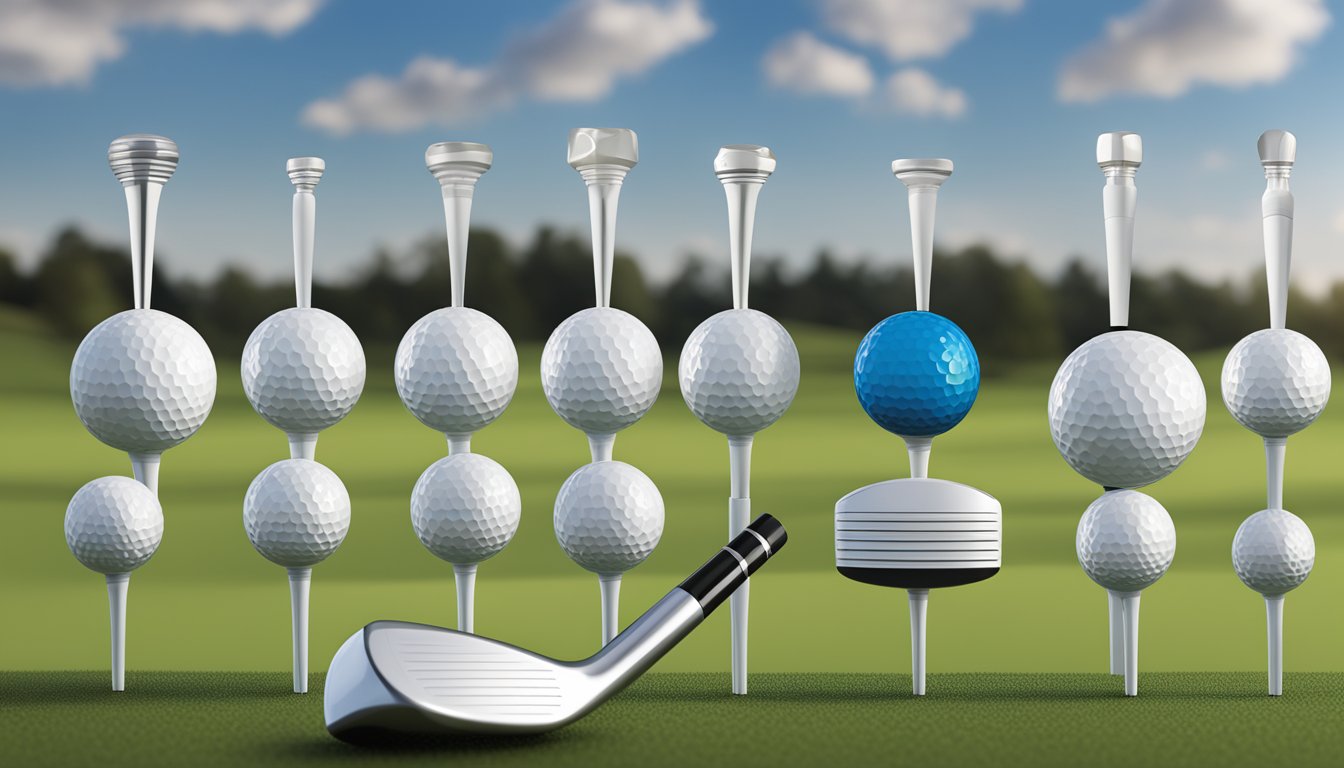If you’re a golfer, you know that choosing the right equipment is essential for a successful game. One of the most overlooked accessories is the golf tee. While it may seem like a small detail, selecting the right size can have a significant impact on your gameplay. In this article, we’ll explore what size golf tee you should use and how it can affect your performance on the course.
Understanding golf tees is the first step in selecting the right size. Golf tees are small pegs that elevate the ball off the ground, allowing for a cleaner shot. They come in various lengths, from 1 1/2 inches to 4 inches. The most common size is 2 3/4 inches, but the size you choose depends on your golf club and personal preference.
Choosing the right tee size is crucial for optimal performance. The length of the tee affects the height of the ball, which can impact the distance and accuracy of your shot. The general rule of thumb is to use shorter tees for fairway woods, hybrids, and irons, and longer tees for drivers. However, the ideal tee height is subjective and varies from player to player. Keep reading to learn more about how golf clubs influence tee selection and how tee size impacts gameplay.
Key Takeaways
- Choosing the right size golf tee can significantly impact your gameplay.
- Golf tees come in various lengths, and the most common size is 2 3/4 inches.
- Tee size depends on your golf club and personal preference.
Understanding Golf Tees
https://www.youtube.com/watch?v=ITeyCNO6iWg&embed=true
Golf tees are small pegs that are used to hold a golf ball in place when teeing off. They are available in various materials, including wood, plastic, bamboo, and brush. Each material has its own unique features, such as durability, flexibility, and resistance to breakage.
The standard tee size is usually around 2 3/4 inches, but they are also available in lengths ranging from 1.5 inches to 4 inches. The most common golf tee size is 2 3/4 inches, and it is suitable for most players and clubs. However, the recommended tee size depends on the club you are using as well as your unique playing style.
Wooden tees are the most traditional and common type of golf tee. They are affordable, disposable, and biodegradable. Plastic tees are more durable and can withstand multiple hits, but they are not biodegradable. Bamboo tees are eco-friendly and biodegradable, but they can be more expensive than other types of tees.
Brush tees are designed to reduce friction and increase accuracy. They have bristles that hold the ball in place, reducing the contact area between the ball and the tee. Anti-slice tees are designed to help prevent slicing, which is when the ball curves to the right or left. Zero friction tees are designed to reduce friction and increase distance.
In summary, choosing the right golf tee depends on your unique playing style and the club you are using. The most common golf tee size is 2 3/4 inches, but other sizes are also available. Wooden tees are the most traditional and common type of tee, but other materials such as plastic, bamboo, brush, anti-slice, and zero friction tees are also available.
Choosing the Right Tee Size
https://www.youtube.com/watch?v=Ze1KzS-sJ6Q&embed=true
When it comes to choosing the right tee size, there are a few factors to consider. The optimal height of the tee is usually half the ball above the clubhead when using a driver. However, the size of the tee can also affect your shot and consistency.
It’s important to pick the perfect tee size for your club. For fairway woods, hybrids, and irons, shorter tees of around 1 ½ or 2 ⅛ inches are ideal. This size tee will give you the best shot angle and help you hit the ball cleanly off the ground. On the other hand, for drivers, the most commonly used length is 2 ¾ inches. Taller tees, such as 3 ¼ or 4 inches, may be suitable for players who have a strong preference or play with larger drivers.
Keep in mind that the size of the tee is a personal preference. Some golfers prefer shorter tees, while others prefer taller ones. It’s important to choose the right golf tee that works for you and your game. Experiment with different sizes and see which one works best for you.
In conclusion, choosing the right tee size is important for your game. Optimal height is half the ball above the clubhead when using a driver. Tee size can affect your shot and consistency, so it’s important to choose the right one for your club. Remember, the size of the tee is a personal preference, so experiment with different sizes and see which one works best for you.
Influence of Golf Clubs on Tee Selection
https://www.youtube.com/watch?v=MgYVhGRpTN4&embed=true
The type of golf club you use can affect your tee selection. For example, drivers have larger club heads than irons, making it easier to hit the ball higher. Therefore, longer tees, such as 2 ¾ inches, are commonly used for drivers. On the other hand, shorter tees, such as 1 ½ or 2 ⅛ inches, are ideal for fairway woods, hybrids, and irons. These tees allow you to hit the ball at a lower height for better control and accuracy.
When selecting a tee size, consider the size of your club head. If you have a larger driver head, you might prefer a taller tee for a higher launch. However, if you have a smaller club head, a shorter tee may be more suitable.
It’s important to note that personal preference also plays a role in tee selection. Some golfers have a preferred tee height based on their swing and comfort level. Experiment with different tee sizes to find what works best for you and your golf club.
Overall, the right tee size depends on your club type, playing style, and personal preferences. Use the guidelines above to select the appropriate tee size for your golf club and improve your game.
Impact of Tee Size on Gameplay
https://www.youtube.com/watch?v=VNX0O2SEdXE&embed=true
Choosing the right size of golf tee can have a significant impact on your gameplay. The size of the tee can affect various aspects of the game, including swing, distance, accuracy, and performance. Here are some of the ways that tee size can affect your game:
Swing
The size of your tee can affect your swing. If you use a tee that is too short, you may end up hitting the ball too low, which can affect the trajectory of your shot. On the other hand, if you use a tee that is too long, you may end up hitting the ball too high, which can also affect the trajectory of your shot. It is important to find the right balance to get the most out of your swing.
Distance
The size of the tee can also affect the distance of your shot. If you use a tee that is too short, you may not be able to get the ball high enough to get the distance you need. If you use a tee that is too long, you may end up hitting the ball too high, which can reduce the distance of your shot. It is important to find the right tee size to get the distance you need.

Accuracy
« Callaway Apex DCB Irons Review: The Best Golf Irons for High Handicap Players
Getting Swing on Plane: Tips for a More Consistent Golf Swing »
The size of your tee can also affect your accuracy. If you use a tee that is too short, you may end up hitting the ball too low, which can cause you to miss your target. If you use a tee that is too long, you may end up hitting the ball too high, which can also cause you to miss your target. It is important to find the right tee size to get the accuracy you need.
Performance
The size of the tee can also affect your overall performance. If you use a tee that is too short or too long, it can affect your consistency and confidence. It is important to find the right tee size to get the performance you need.
In conclusion, choosing the right size of golf tee is crucial for your gameplay. It can affect various aspects of the game, including swing, distance, accuracy, and performance. Take the time to experiment with different tee sizes to find the one that best suits your game.
Adapting to Course Conditions and Skill Levels
When it comes to choosing the right size golf tee, it is essential to adapt to the course conditions and your skill level. You want to manage your tee height in a way that gives you the best view of the ball while also being comfortable and confident in your swing.

For golfers with a higher skill level, shorter tees (1 ½ or 2 ⅛ inches) are ideal for fairway woods, hybrids, and irons. This is because shorter tees allow for more control over the ball’s trajectory, making it easier to hit the ball cleanly and accurately. Additionally, shorter tees are less likely to break, which can be an advantage for pros who hit the ball with more power.
For drivers, 2 ¾-inch tees are the most commonly used length. This length is suitable for most skill levels and provides a good balance between control and distance. However, taller tees, such as 3 ¼ or 4 inches, may be suitable for players who have a strong preference or play with larger drivers. Keep in mind that taller tees may require a higher degree of skill to manage, as they can lead to higher ball flight and more spin.
Ultimately, the type of tee you use will depend on your individual skill level and preferences. As you gain more experience on the course, you may find that you prefer a certain type of tee for specific shots or course conditions. Experimenting with different tee sizes and materials can help you find the perfect fit for your game.
Additional Considerations for Tee Selection
When selecting a golf tee, there are a few additional factors to consider beyond the size of the tee. These factors can impact your game and help you achieve better results.

Tee Material
The material of the tee can impact how long it lasts and how it interacts with the golf ball. Wooden pegs are a popular choice, but they can break easily and may not provide consistent results. Portable tees are convenient but may not be as durable as other options. Anti-slice tees and zero friction tees are designed to reduce spin and resistance, respectively, but may not work for everyone. Consider trying out different materials to find the one that works best for you.
Tee Box Conditions
The condition of the tee box can also impact your tee selection. If the tee box is soft or muddy, you may want to use a longer tee to help elevate the ball and avoid sinking into the ground. Conversely, if the tee box is firm or hard, a shorter tee may be appropriate to avoid hitting the ball too high.
Club Selection
The club you are using can also impact your tee selection. For example, a driver typically requires a longer tee to help achieve optimal launch angle and distance. On the other hand, irons and hybrids may require shorter tees to help with accuracy and ball placement.
Golf Ball Type
The type of golf ball you are using can also impact your tee selection. For example, if you are using a high-spin ball, you may want to use a tee that reduces spin to help keep the ball in play. Conversely, if you are using a low-spin ball, you may want to use a tee that promotes spin to help maximize distance.
By considering these additional factors, you can select the right tee for your game and improve your overall performance on the course.
Frequently Asked Questions
https://www.youtube.com/watch?v=J3ChNtg7RP0&embed=true
What is the best golf tee size for beginners?
As a beginner, it is recommended that you use a longer tee, such as a 3.25 inch tee. This will give you more margin for error and help you get the ball airborne easier.
What are the best golf tees?
The best golf tees are ones that are durable, easy to use, and fit your personal preference. Some popular options include wooden tees, plastic tees, and brush tees.
What is the difference between 2.75 and 3.25 golf tees?
The main difference between 2.75 and 3.25 golf tees is the length. 2.75 inch tees are shorter and are typically used with irons and hybrids, while 3.25 inch tees are longer and are typically used with drivers.
What is the average golf tee length?
The average golf tee length is around 2.75 inches. However, the length of the tee you use should depend on the club you are using and your personal preference.

What are the golf tees used on the PGA Tour?
The golf tees used on the PGA Tour vary depending on the player’s preference. Some players prefer wooden tees, while others prefer plastic or brush tees.
How do I choose the right height for my tee?
Choosing the right height for your tee depends on the club you are using and your personal preference. As a general rule, you want the ball to be teed up so that the equator of the ball is level with the top of the clubface when the club is grounded. Experiment with different tee heights to find what works best for you.










